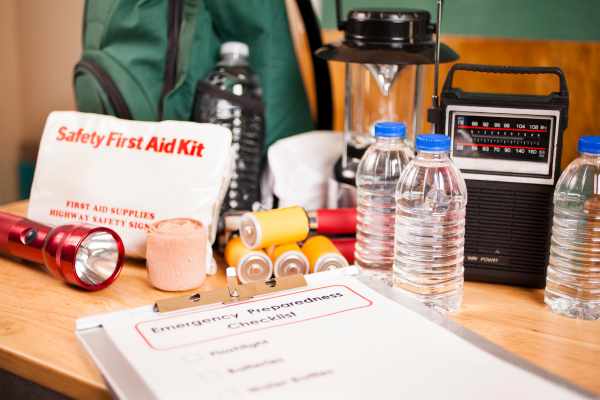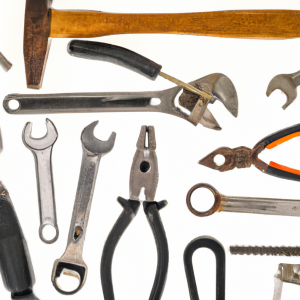Are you prepared for the unexpected? Natural disasters can strike at any moment, leaving you and your community vulnerable. But don’t worry, we’ve got you covered.
In this article, we will guide you through the steps of preparing for natural disasters. From understanding the different types of disasters to assessing your risk and vulnerability, creating an emergency plan, assembling an emergency kit, and building resilience in your community, we will equip you with the knowledge and tools to stay safe and protect what matters most.
Let’s get started.

Key Takeaways
- Understanding different types of natural disasters helps in preparing emergency kits, creating evacuation plans, and staying informed through reliable sources.
- Researching the history of natural disasters in your area and assessing risk and vulnerability is crucial in making informed decisions about preparedness measures.
- Creating an emergency plan involves gathering essential supplies, establishing a communication plan, creating an evacuation plan, and staying informed.
- Assembling an emergency kit with essential supplies like food, water, flashlights, batteries, and a first aid kit is essential for being prepared during a natural disaster.
Understanding the Types of Natural Disasters
Understanding the types of natural disasters is crucial for preparation. It allows you to be aware of the potential risks in your area and take appropriate measures to protect yourself and your loved ones.
There are several types of natural disasters, each with its own characteristics and potential hazards. For example, hurricanes can bring strong winds and heavy rainfall, leading to flooding and destruction.
Earthquakes can cause violent shaking of the ground, resulting in buildings collapsing and landslides. Tornadoes can produce powerful winds that can cause significant damage to structures and vehicles.
Floods can occur due to heavy rainfall or the overflow of rivers, causing widespread damage to homes and infrastructure. By understanding the different types of natural disasters, you can better prepare by having emergency kits, creating evacuation plans, and staying informed through reliable sources.
Stay safe and take the necessary steps to protect yourself and your community.
Assessing Your Risk and Vulnerability
Evaluating your risk and vulnerability is crucial when getting ready for potential emergencies. By taking the time to assess your situation, you can better understand the specific hazards that may affect you and your community.
Start by researching the history of natural disasters in your area and consider the likelihood of them occurring again. Look into the vulnerability of your home and surroundings, such as the stability of the building and the potential for flooding or landslides.
Additionally, take into account your personal circumstances, like any disabilities or medical conditions that may require special attention during emergencies. Understanding your risk and vulnerability will help you make informed decisions about preparedness measures, such as creating an emergency kit, developing a communication plan, and knowing evacuation routes.
Remember, being prepared not only ensures your safety but also contributes to a sense of belonging within your community.
Creating an Emergency Plan
To create an emergency plan, start by identifying potential hazards in your area and develop a strategy to address them. Consider these four essential steps to ensure your safety and the safety of your loved ones:
- Gather essential supplies: Stock up on non-perishable food, water, flashlights, batteries, and a first aid kit. Having these items readily available will provide a sense of security during a disaster.
- Establish a communication plan: Designate a trusted contact who can serve as a central point of communication for your family. Share important phone numbers and establish a meeting place in case you get separated.
- Create an evacuation plan: Identify safe evacuation routes and alternate routes. Practice evacuating your home with your family so that everyone knows what to do in case of an emergency.
- Stay informed: Sign up for emergency alerts and stay updated on local weather conditions. Being aware of potential dangers will help you make informed decisions to protect yourself and your community.
By following these steps, you can create a well-prepared emergency plan that will give you a sense of belonging and peace of mind during uncertain times.
Assembling an Emergency Kit
Assembling an emergency kit involves gathering essential supplies. These supplies include non-perishable food, water, flashlights, batteries, and a first aid kit. It’s important to have enough food and water to last at least three days for each person in your household. Choose foods that don’t require refrigeration and have a long shelf life, such as canned goods, granola bars, and dried fruits. Don’t forget to include a manual can opener.
Water is crucial during an emergency, so make sure to have at least one gallon per person per day. Flashlights and batteries are essential for when the power goes out, so keep a few sets handy. In case of any injuries during a natural disaster, a first aid kit is necessary. Include bandages, antiseptic wipes, pain relievers, and any necessary prescription medications.
Remember to regularly check and update your emergency kit to ensure that everything is in working order. By doing so, you will stay safe and prepared for any unexpected events.
Building Resilience in Your Community
Building resilience in your community involves fostering strong relationships, promoting communication, and developing effective emergency response plans.
By building strong relationships within your community, you create a support system that can help during times of crisis. Get to know your neighbors, join local organizations, and participate in community events. This will not only foster a sense of belonging, but also ensure that everyone is aware of each other’s needs and can provide assistance when needed.
Communication is key in building resilience. Stay informed about local emergency plans and make sure your community is aware of them as well. Encourage open dialogue and information-sharing, whether it’s through community meetings, social media groups, or neighborhood newsletters.
Finally, develop effective emergency response plans that involve everyone in your community. Identify potential hazards, establish evacuation routes, and designate meeting points. Regularly review and practice these plans to ensure they are effective and everyone knows what to do in case of a disaster.
By building resilience in your community, you can work together to overcome any challenges that may come your way.
Frequently Asked Questions
How can I secure important documents like passports and birth certificates during a natural disaster?
Secure important documents like passports and birth certificates during a natural disaster by storing them in a waterproof and fireproof container. Keep them in a designated spot, inform family members, and consider making digital copies as a backup.
What steps should I take to protect my pets and ensure their safety during an emergency situation?
To protect your pets during an emergency, create a pet emergency kit with food, water, medication, and comfort items. Keep their identification up to date and have a plan for their care in case you can’t stay together.
Are there any specific measures to consider for individuals with disabilities or special needs during a natural disaster?
During a natural disaster, it’s important to consider the needs of individuals with disabilities or special needs. Make sure to have a plan in place, communicate with caregivers, and have necessary supplies readily available.
What are some ways to communicate and stay connected with loved ones during a crisis when regular communication channels may be disrupted?
To communicate and stay connected with loved ones during a crisis when regular channels are disrupted, use alternative methods like text messaging, social media, or walkie-talkies. Make sure everyone has a plan in place beforehand.
How can I assist my elderly neighbors or community members who may require additional support during a natural disaster?
To assist elderly neighbors during a natural disaster, check in on them regularly, offer to help with tasks like securing their home, provide them with emergency supplies, and help them create a communication plan with their loved ones.
Conclusion
In conclusion, preparing for natural disasters is crucial for your safety and well-being. By understanding the various types of natural disasters and assessing your risk and vulnerability, you can better prepare for potential emergencies.
Creating an emergency plan and assembling an emergency kit will ensure that you have the necessary resources and strategies in place.
Lastly, building resilience in your community will help everyone come together and support one another during times of crisis.
Remember, taking these proactive steps can make a significant difference in your ability to effectively respond and recover from natural disasters. Stay informed, be prepared, and stay safe.


